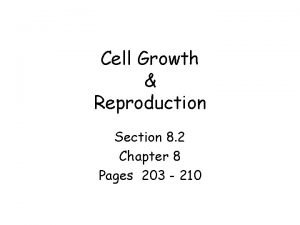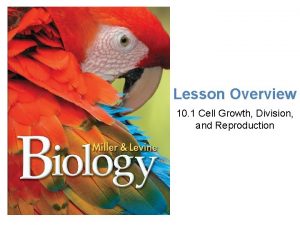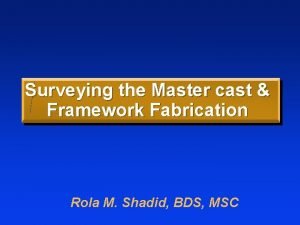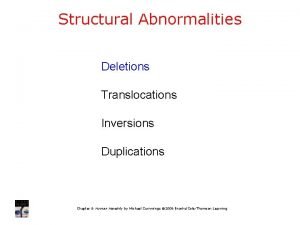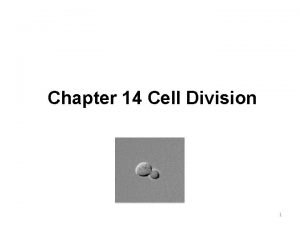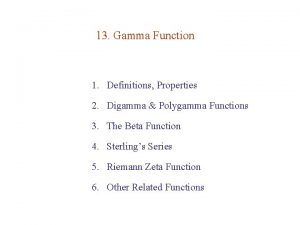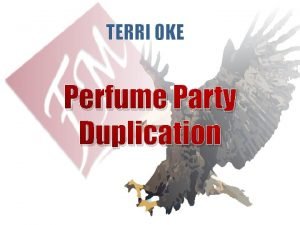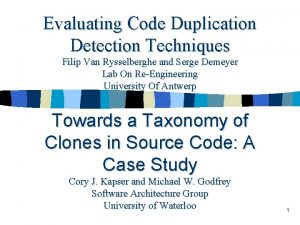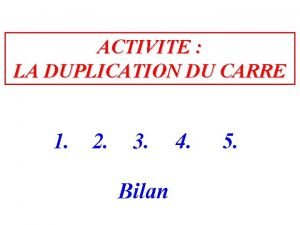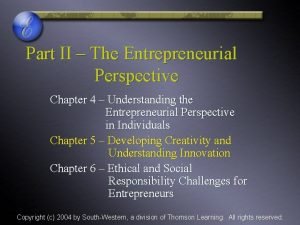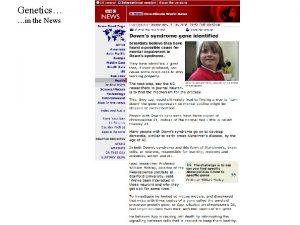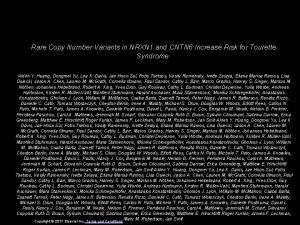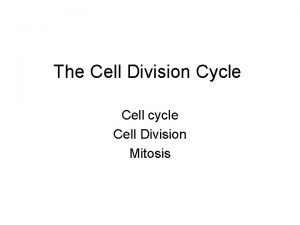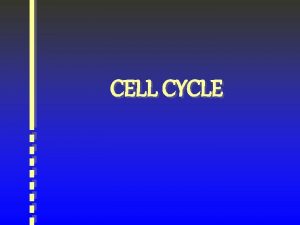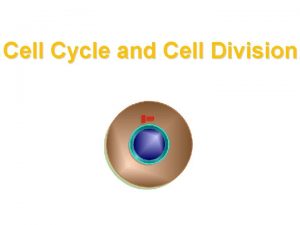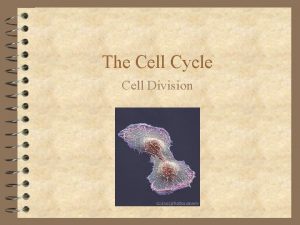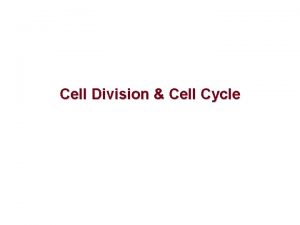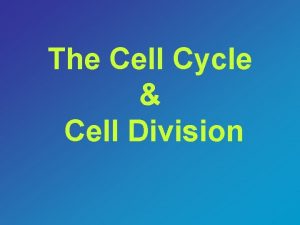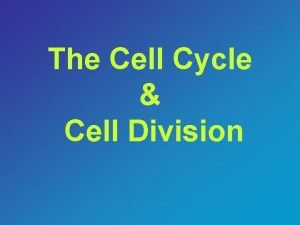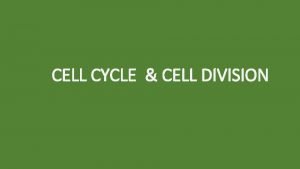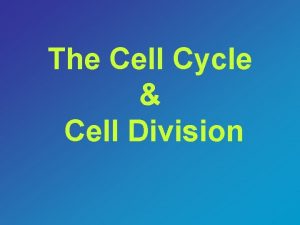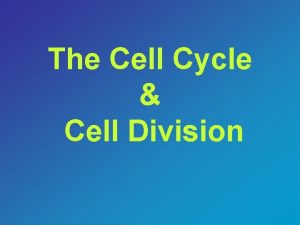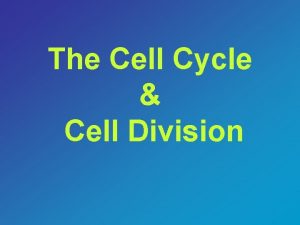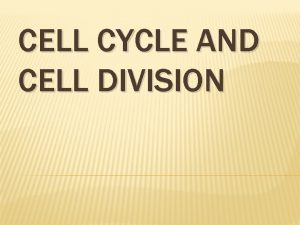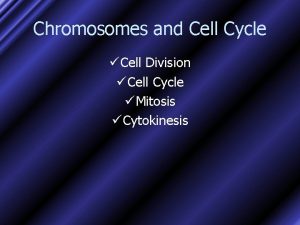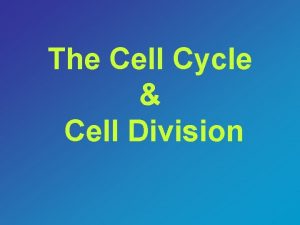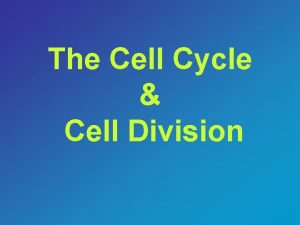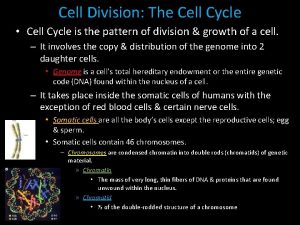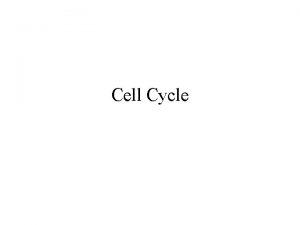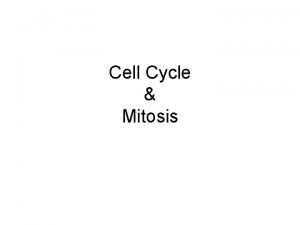The Cell Cycle Growth Duplication Division Cell Growth

























- Slides: 25

The Cell Cycle Growth, Duplication & Division

Cell Growth • A cell size is limited by its surface area (SA) to volume (V) ratio

Surface Area to Volume Ratio • A cells SA is the area covered by its membrane – The cells ability to transport material is determined by its SA • A cells V is the area occupied by its cytoplasm (cytosol & organelles) – The cells need to transport material is determined by its V

SA: V Determines Cell Size • As a cell grows its V increases faster than its SA • Once a cell reaches the point where its ability to transport materials (SA) cannot meet its need to transport materials (V) it will stop growing or it will divide

Cell Size & Transport • Once inside the cell, substances move by diffusion or by motor proteins pulling them along the cytoskeleton • Cells remain small because diffusion and cytoskeletal transportation over long distances is slow and inefficient

Eukaryotic Cell Cycle • An orderly sequence of events in which a cell grows, duplicates its contents and then divides in two

Stages of the Cell Cycle • Interphase • Mitosis • Cytokinesis

Interphase • During interphase the cell grows, makes organelles and duplicates (copies) its DNA.

Interphase • G 1: the cell grows, makes organelles and prepares for S-phase • S-phase “synthesis phase” This is when DNA replication occurs, i. e. the cell copies its DNA • G 2 the cell grows, makes organelles and prepares for mitosis and cytokinesis

Mitosis: • Division of the nucleus • 4 Phases – Prophase – Metaphase – Anaphase – Telophase

DNA • DNA can be found in one of two forms during the cell cycle: chromatin or chromosome. Both consist of DNA wrapped around proteins – Chromatin is the relaxed or uncondensed form of DNA. In this state, DNA looks like thread or spaghetti – A Chromosome forms when chromatin becomes highly condensed. In this state, DNA looks like a rod or an X (two rods)



Prophase • Chromatin condenses into chromosomes • The nuclear membrane breaks down • Mitotic spindle begins to form between the poles

Metaphase • Chromosomes attach to the mitotic spindle and line up along the equator of the cell

Anaphase • Microtubules of the mitotic spindle shorten, pulling chromosomes to opposite ends of the cell

Telophase • Nuclear envelope reforms • Chromosomes decondense • The mitotic spindle is disassembled

Cytokinesis • Division of the cytoplasm (cytosol & organelles) – In animal cells a cleavage furrow forms along the equator and pinches inward until the cell divides


The End Result: • The cell cycle produces two daughter cells that are genetically identically to the parent cell

Asexual Reproduction • Many organisms can reproduce without exchanging genetic material (DNA) with another organism. This is called asexual reproduction. • Very simple organisms like bacteria can reproduce by simply dividing their cell in half in a process called binary fission. – This process does NOT include mitosis; there is no nucleus, chromosomes don’t condense, and no spindle fibers.

Asexual Reproduction in Animals • Budding: smaller organism begins to grow from adult and detaches when it is mature • Fragmentation: adult organism breaks into smaller pieces, which can each grow into individual organisms.

Asexual Reproduction in Plants • Most plants can reproduce asexually using special stems (called “stolons” by biologists and “runners” by gardeners) or by growing from a cutting.

Advantages of Asexual Reproduction • Don’t have to find a mate • Usually a simple process that doesn’t require a lot of resources • Quick process that can produce many offspring

Disadvantage of Asexual Reproduction • Since all offspring are genetically identical to the parent, there is not a wide variety of traits. If there is a change in the environment, it could wipe out the entire population. Crops with genetic variation may be better able to withstand an attack by pests than a field of genetically identical crops.
 Section 10-2 cell division
Section 10-2 cell division Cell cycle and cell division
Cell cycle and cell division Phases of cell cycle
Phases of cell cycle Chapter 8 cell growth and division section 8-2 answer key
Chapter 8 cell growth and division section 8-2 answer key Cell growth division and reproduction
Cell growth division and reproduction Master cast outline
Master cast outline Non reciprocal translocation
Non reciprocal translocation How to maintain a qualified forensic duplicate
How to maintain a qualified forensic duplicate Cell continuity definition
Cell continuity definition State and prove legendre's duplication formula
State and prove legendre's duplication formula Perfume duplication
Perfume duplication Code duplication detection
Code duplication detection Duplication du carré
Duplication du carré The entrepreneurial perspective
The entrepreneurial perspective Monoploidy
Monoploidy Nrxn copy number variant
Nrxn copy number variant Biology.arizona.edu/cell bio/activities/cell cycle/01.html
Biology.arizona.edu/cell bio/activities/cell cycle/01.html Short division vs long division
Short division vs long division Synthetic divisin
Synthetic divisin Hcf
Hcf It is the shorthand method of polynomial division
It is the shorthand method of polynomial division Hát kết hợp bộ gõ cơ thể
Hát kết hợp bộ gõ cơ thể Slidetodoc
Slidetodoc Bổ thể
Bổ thể Tỉ lệ cơ thể trẻ em
Tỉ lệ cơ thể trẻ em Voi kéo gỗ như thế nào
Voi kéo gỗ như thế nào



